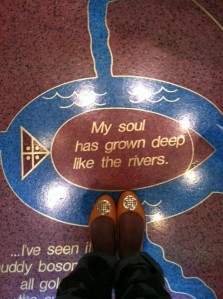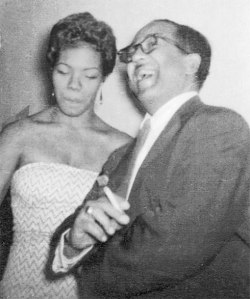
Back in the 1950s, writer Maya Angelou was singing and dancing her way across Europe and America to appear in clubs, movies, and plays.
African-American writer Maya Angelou died this week at age 86. Starting Friday, May 31, 2014, the Schomburg Center for Research in Black Culture in Harlem, New York City, will showcase a collection of her papers, manuscripts and letters. Maya Angelou is no stranger to the Schomburg Center. In 1991, the Schomburg expanded to include a new addition and Ms. Angelou was a guest at the opening.
The 1991 expansion of the Schomburg Center was the Langston Hughes Building. The structure is named after African-American poet Langston Hughes, the leader of the Harlem Renaissance. Maya Angelou met him in California once when he came to hear her sing.
The Langston Hughes Building contains an auditorium that seats 340 guests. Although impressive, the auditorium is of no interest to us here. It is the lobby that draws our attention.
The lobby is spacious, elegant, and flooded with natural light streaming through its many tall windows. The windows look out onto a garden but the real conversation piece is the floor. Embedded in the terrazzo tile is a design honoring the poetry of Langston Hughes. “Rivers” was inspired by Hughes’ well-known poem, ” A Negro Speaks of Rivers.” This type of design is called a cosmogram, as it treats mystical themes of nature and the meaning of life. Blue rivers snake through rust-colored clay, evoking the Earth.
The design is pleasing, with its tribal symbols and poetic quotes. Looking closer even, we see that there is a fish shape in the middle. Inside the fish is a quote from the poem.

A quote from “A Negro Speaks of Rivers,” by Langston Hughes appears in the cosmogram in the Langston Hughes Building Lobby.
If we had superpowers and could see through the tile of the fish and underneath the floor, we would discover that there is something buried there. It is a vessel, made of metal, and, fittingly, we think later, shaped like a book. It is sealed. If we were to open it, which we won’t (and can’t), we would discover that it contains the cremated ashes of Langston Hughes himself. So the cosmogram, besides being beautiful, is useful. It is a tomb.
So, at the 1991 opening of the Langston Hughes Building, guests filled up the lobby and turned it into a dance floor. Someone cranked up the music and everyone boogied down. And this is how Maya Angelou and others ended up doing the proverbial dance on a friend’s grave.

In February 1991, the Schomburg Center for Research in Black Culture in Harlem observed the 89th birthday of the poet Langston Hughes and the beginning of Black History Month. Mr. Hughes’s ashes are buried beneath the floor of the auditorium, and in an African Custom of ancestral return, the writers Amiri Baraka and Maya Angelou danced atop them.
Published NYT Metro, Saturday, Feb. 22, 1991
CREDIT: Chester Higgins, Jr/The New York Times
For more on Maya Angelou, click here.
























